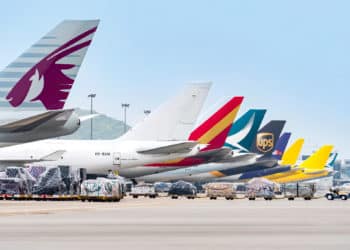No products in the cart.
Air freight growth continues in June, if more slowly
The International Air Transport Association released its air freight market analysis for June 2014, showing an overall 2.3% year-over-year increase in worldwide cargo traffic. The growth came from a 2.9% increase in international traffic, while domestic traffic in fact fell 1.3%. For the first half of 2014, total traffic was up 4.1%.
 The rate of growth in June is down from the 4.7% y-o-y gain IATA reported in May, and at the low end of the year-over-year growth rates reported in the first half, but IATA’s outlook is fairly positive nonetheless: “The performance of air freight markets has closely followed developments in world trade and business activity, which both showed solid gains toward the end of 2013, only to taper off earlier this year. Most recent data, however, points to resumption in prior improvements in these demand drivers. The results have been mixed however, with some regions showing stronger gains than others.”
The rate of growth in June is down from the 4.7% y-o-y gain IATA reported in May, and at the low end of the year-over-year growth rates reported in the first half, but IATA’s outlook is fairly positive nonetheless: “The performance of air freight markets has closely followed developments in world trade and business activity, which both showed solid gains toward the end of 2013, only to taper off earlier this year. Most recent data, however, points to resumption in prior improvements in these demand drivers. The results have been mixed however, with some regions showing stronger gains than others.”
It is also worth pointing out that data gathered by Netherlands-based WorldACD have indicated stronger growth so far this year than what is being shown by IATA. As we reported earlier this week, World ACD found air freight demand in June to be up 4.8% (compared to IATA’s2.3%), and the gap was similar in May, with WorldACD data showing 7.5% growth while IATA’s data showed 4.5%. Also worth noting is that WorldACD found June to be the first month in two-and-one-half years in which air freight yields grew on a year-over-year basis – up 0.9%.
The two organizations collect data in different ways, with IATA gathering reports of cargo traffic (in revenue tonne kilometers flown) from member airlines, while WorldACD gathers cargo volume data (in tonnes) directly from the airwaybills of over fifty carriers. Given the different methodologies, one would expect some differences in the result, but not as much as we’ve seen in the last few months.
Turning back to IATA’s report, we look at the June results by geographic region:
Middle East: Carriers from the Middle East continue to report strong growth in their cargo business, with traffic up 7.0% y-o-y in June. For the first half of 2014, Middle East-based carriers reported their cargo traffic up 9.1%.
Asia-Pacific: Airlines based in the Asia-Pacific region have long carried the greatest share of global cargo traffic (about 40%), and they continue to do so. However, in the last few years, they have faced ever-increasing competition from carriers based in the Middle East, and this, combined with the weak demand environment led to declining traffic. Beginning in January, and continuing through the first half of 2014, Asia’s carriers have reversed this trend, and are now reporting solid growth, with traffic up 4.9% in June, and 4.6% for the half. Commenting on the performance of Asia-Pacific carriers, IATA said: “Latest (May) data shows that regional trade volumes remain at improved levels, after continued decline throughout Q1. Moreover, although export orders for China remain volatile, there was a strong increase in July – suggesting the upturn in regional trade growth could be sustained in the months ahead. In addition, manufacturing activity is expanding again for the first time since December 2013.”
Europe: The recovery of the European economy has slowed somewhat, and the region’s carriers reported cargo traffic down 1.5% in June. IATA points out that this may also reflect some loss of market share to Asian carriers. For the first half of 2014, European carriers reported cargo traffic up 3.2%.
North America: Carriers in this region reversed their trend of modest increases in cargo traffic, with June traffic down slightly (0.1%). However, the decrease was caused by a fall in domestic traffic, which outweighed 1.9% growth in international traffic. For the half, North American carriers reported cargo traffic up 1.6%. Looking ahead, IATA said: “Latest data show a rebound in trade volumes and underlying growth trends in business activity are positive, which could provide some support stronger growth in trade and air freight demand ahead.”
Latin America: Trade in the Latin American region deteriorated in the early part of this year, and this curtailed air freight demand for the region’s carriers. The region’s carriers reported a spike in cargo traffic in May, but June saw a return to the trend of decline with traffic down 3.4%. For the first six months of 2014, Latin American carriers reported their cargo traffic up 0.5%.
Africa: Air freight demand in Africa remains volatile, with cargo traffic growing in one month and declining the next. In June, cargo traffic for the region’s carriers was up 4.8%. This follows a 7.2% gain in May, and IATA said: “The latest trade data shows a rise in volumes, which could provide support for stronger air freight demand in the months ahead.”




